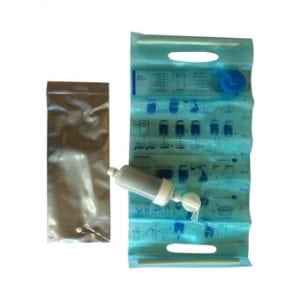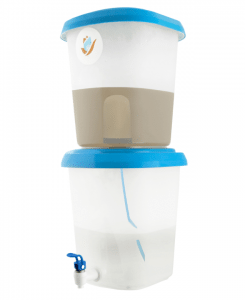
Agriculture
December 27, 2023
AquaFilter Family
Read SolutionImplemented by
Aquabox, UK

Updated on January 8, 2024
·Created on June 10, 2016
The DayOne Waterbag is an all-in-one water transport and purification backpack that uses P&G Purifier of Water packets for water treatment.
DayOne Waterbag is a personal water treatment backpack with a built-in filter and an initial supply of 60 Proctor and Gamble (P&G) Purifier of water flocculant-disinfectant packets. It is for water collection, transport, treatment, and protected storage.
This product is discontinued and no longer available.
Target SDGs
SDG 6: Clean Water and Sanitation
SDG 3: Good Health and Well-Being
Market Suggested Retail Price
$79.99
Target Users (Target Impact Group)
Household
Distributors / Implementing Organizations
This product has been implemented by organizations such as AmeriCares, care, ChildFund, World Vision, Giving Children Hope, ADRA, and International Medical Corps.
Regions
Worldwide
Manufacturing/Building Method
Unknown
Intellectural Property Type
Patent
User Provision Model
This product is available for purchase as individual units and bulk orders from the DayOne website. In addition, a person or organization can "sponsor" Waterbags to be distributed. DayOne Response works with a variety of organizations that implement Waterbags in areas of disaster.
Distributions to Date Status
The exact number of distributions to date is unknown, however, the DayOne Waterbag has been deployed in over 20 countries, including the Philippines, Nepal, Thailand, Cambodia, Benin, Ghana, the Ivory Coast, Zimbabwe, Uganda, Venezuela, Nicaragua, and Haiti, among others.
Description of the combined methods
Flocculation, Disinfection, Filtration
Manufacturer-specified water treatment rate (L/hr)
20 L/hr
Bacteria reduction
6 log
Virus reduction
4 log
Protozoa reduction
3 log
Heavy metals and/or arsenic reduction
Yes, reduction rate unknown
Maximum recommended influent turbidity level (NTU)
Unknown
Effluent turbidity levels (NTU)
0.25 – 3.2 NTU
Safe water storage capacity (L)
10 L
Manufacturer-specified lifetime volume (L)
600 L
Consumables
P&G treatment packets
Design Specifications
The Waterbag is made from durable Food Grade plastic that stores up to 10 L of water. The water is collected in the Waterbag and a PUR packet is added to the bag and is closed. The bag is then hung (from a branch or other device) and mixed for 5 minutes. The bag should be left hanging for 25 minutes, allowing all particles to settle at the bottom. Water can then be dispensed with the nozzle on the bag.
An instructional video is available on the DayOne website.
Technical Support
Technical support is provided by DayOne Response.
Replacement Components
The Waterbag include 60 P&G packets with each purchase. Replacement P&G packets are 19.99 USD for an additional 12 or 99.99 USD for an additional 240. One packet is used for each 10 L of water.
Lifecycle
The Waterbag can be stored at room temperature for 10 years from date of manufacture. P&G packets can be stored for 3 years from date of manufacture.
Manufacturer Specified Performance Parameters
The product was designed for the removal of turbidity, cysts (>3 logs), viruses (>4 logs), bacteria (>6 logs) and arsenic from contaminated water sources such as creeks, rivers, lakes, and ponds.
Vetted Performance Status
The US Environmental Protection Agency (US EPA) demonstrated that P>M Purifier of Water removed >99.9999% of pathogenic bacteria, >99.99% of viruses, and >99.9% of parasites including Giardia and Cryptosporidium. The P>M Purifier of Water packets have been tested by Centers for Disease Control and Prevention (CDC), US EPA, and University of Michigan.
Safety
The P>M Purifier of Water powder is hazardous if ingested. If swallowed, contact poison control center and sip on a glass of water for 15 – 20 minutes. If in eye, rinse eyes thoroughly with water for 15-20 minutes. If on skin, remove contaminated clothing and rinse skin with water for 15 – 20 minutes.
The product is not appropriate for soapy water, sea or saltwater, blackwater, or water contaminated with gasoline.
Complementary Technical Systems
The P>M Purifier of Water is essential to the function of the Waterbag.
Academic Research and References
Lougheed, T., 2006, “A Clear Solution for Dirty Water,” Environmental Health Perspectives, 114, pp. 424-427.
Blanton, E., et al., 2010, “Evaluation of the Role of School Children in the Promotion of Point-of-Use Water Treatment and Handwashing in Schools and Households-Nyanza Province, Western Kenya,” The American Journal of Tropical Medicine and Hygiene, 82, pp. 664-671.
Doocy, S., Burnham, G., 2006, “Point-of-use water treatment and diarrhoea reduction in the emergency context: an effectiveness trial in Liberia,” Tropical Medicine and International Health, 11, pp. 1542-1552.
Allgood, G., 2009, “Safe drinking water for the most vulnerable,” International Nursing Review, 56, pp. 273-275.
Souter, P.F., et al., 2003, “Evaluation of a new water treatment for point-of-use household applications to remove microorganisms and arsenic from drinking water,” Journal of Water and Health, 1, pp. 73–84.
Crump, J., et al., 2005, “Household based treatment of drinking water with flocculant-disinfectant for preventing diarrhoea in areas with turbid source water in rural western Kenya: cluster randomised controlled trial,” BMJ 2005;331:478.
Reller, M.E., et al., 2003, “A randomized controlled trial of household-based flocculant-disinfectant drinking water treatment for diarrhea prevention in rural Guatemala,” The American Journal of Tropical Medicine and Hygiene, 69, pp. 411-419
Compliance with regulations
The product is compliant with the US EPA standards for safe drinking water.
Evaluation methods
The product was evaluated through laboratory water tests by the US EPA. In the HIF Emergency Household Water Filter Challenge, filters were tested for ease-of-use, effectiveness, lifespan, robustness, and affordability and evaluated in a matrix for different disaster scenarios.
Other Information
The product is not appropriate for soapy water, sea or saltwater, blackwater, or water contaminated with gasoline.

Agriculture
December 27, 2023
Implemented by
Aquabox, UK

Agriculture
January 11, 2024
Implemented by
Kenya Ceramic Project (KCP)

Agriculture
January 10, 2024
Implemented by
NativeEnergy

Agriculture
January 2, 2024
Implemented by
Klorfasil

Agriculture
December 29, 2023
Implemented by
RealRelief

Agriculture
January 4, 2024
Implemented by
Basic Water Needs

Agriculture
January 2, 2024
Implemented by
wateroam

Agriculture
December 27, 2023
Implemented by
Aqua Clara International

Agriculture
January 10, 2024
Implemented by
Dr. David Manz, University of Calgary

Agriculture
January 11, 2024
Implemented by
Kohler
Have thoughts on how we can improve?
Give Us Feedback
As per Bob: Manufacturing
of this type of product requires documented process and assembly
standards. In volumes of 100 special
attention needs to be paid to ensure that each unit is not a unique “one ofâ€
but rather follows and industrialized, documented and controlled assembly and
test process. With the exception of the
setup and assembly/test of the actual UV unit no special manufacturing
processing is required.
Trained users imply that training processes and support materials will be made available. Ongoing application and service support will be required. Trainers will be required to develop user guides and training classes.
This product states that repair parts will not be available and that support will not be provided to the customer by the manufacturer. This is not practical for an installed base of more than ~50 units. The global distribution to both Africa and India will require 24 x 7 staffing and when repair is required the unit will either need to be returned for repair or repaired on site by someone sent out from the factory. Neither approach is practical.